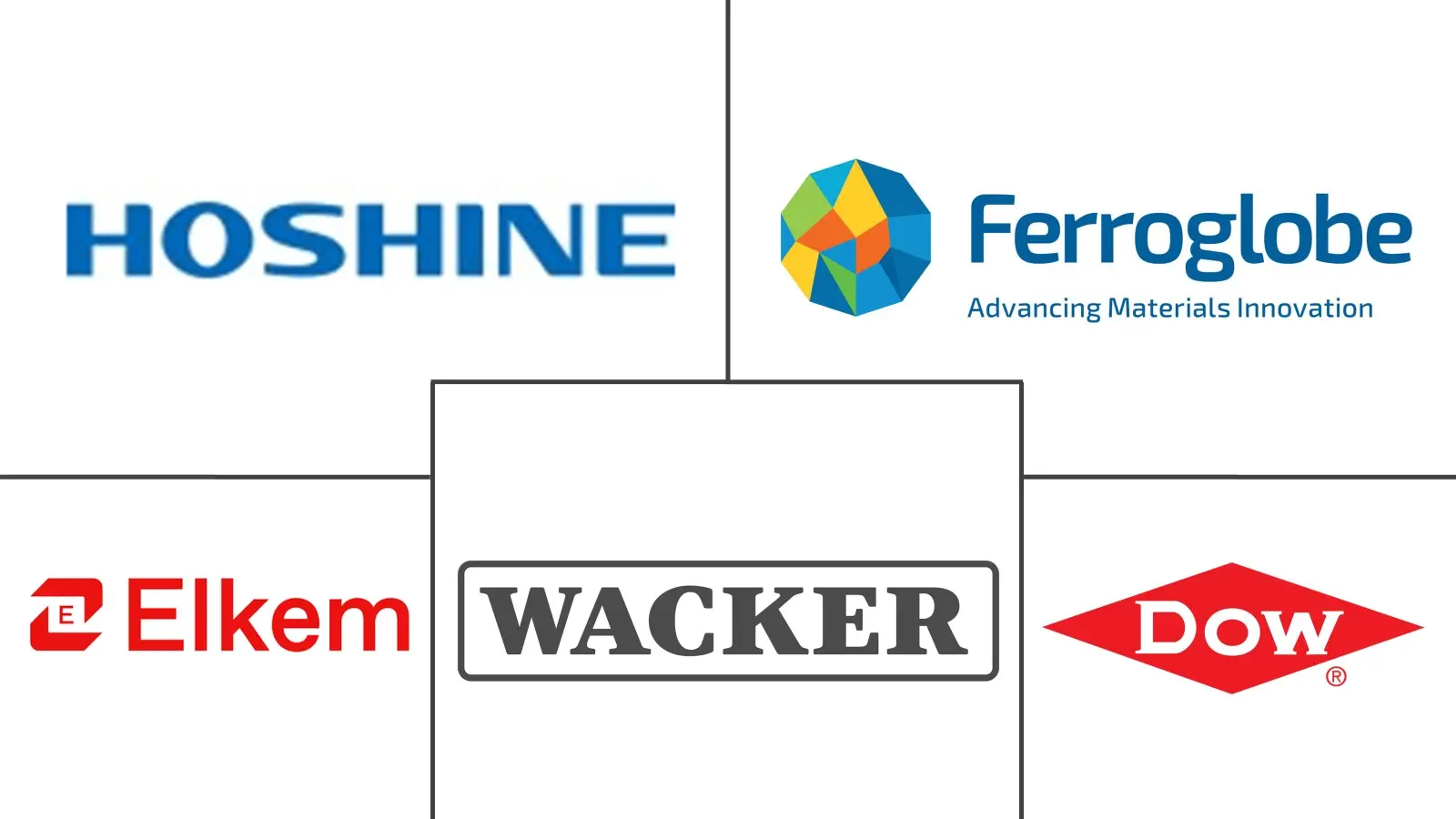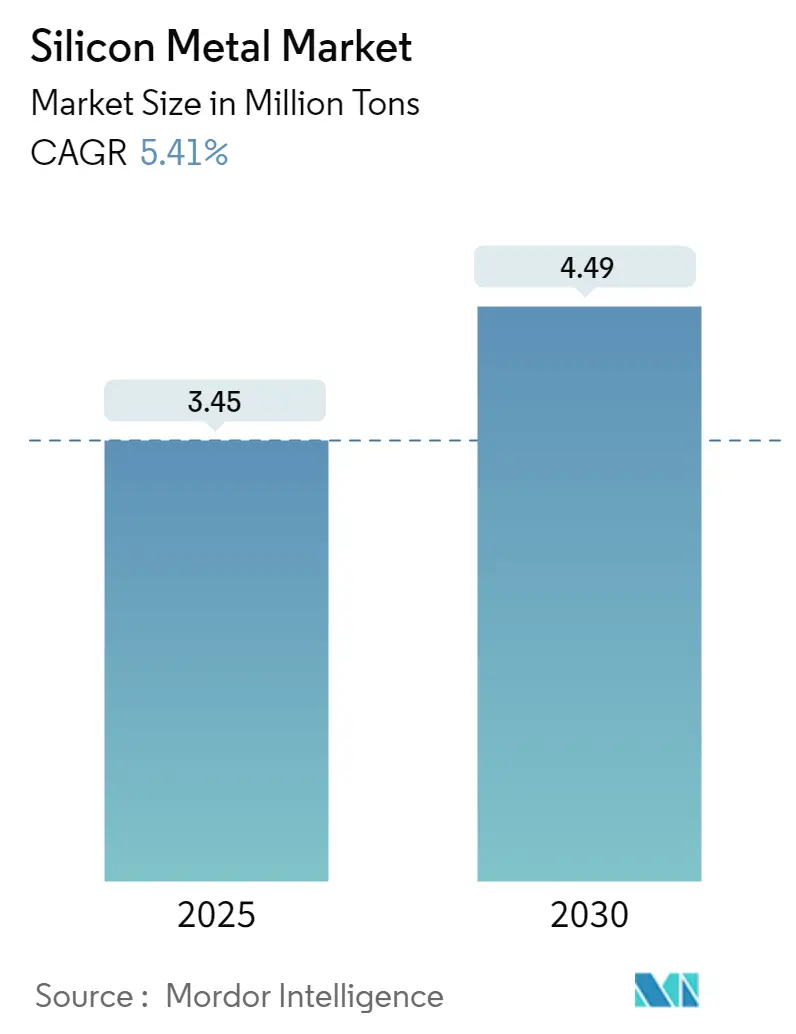
Silicon Metal Market Analysis
The Silicon Metal Market size is estimated at 3.45 million tons in 2025, and is expected to reach 4.49 million tons by 2030, at a CAGR of 5.41% during the forecast period (2025-2030).
The silicon metal industry is experiencing significant transformation driven by evolving global industrial dynamics and technological advancements. According to the US Geological Survey (USGS), global silicon production amounted to approximately 8.8 million tons in 2022, marking a 3.2% decline compared to the previous year. This fluctuation in production levels reflects the industry's sensitivity to global economic conditions and energy cost variations. The industry has been particularly impacted by rising electricity costs in major producing regions, leading to strategic production adjustments and regional capacity shifts. Manufacturing efficiency and sustainable silicon manufacturing practices have become increasingly critical as producers seek to maintain competitiveness while managing environmental responsibilities.
The semiconductor sector, a crucial end-user of silicon metal, continues to shape market dynamics significantly. The Semiconductor Industry Association (SIA) reported that global semiconductor sales reached USD 574.1 billion in 2022, registering a year-on-year growth of 3.3%. However, the World Semiconductor Trade Statistics projects a decline of 4.1% to USD 557 billion in 2023, with the Asia-Pacific region expected to experience the most substantial decrease of 7.5%. This fluctuation in semiconductor silicon demand has prompted industry players to diversify their supply chains and invest in new production capabilities across different regions, particularly in emerging markets.
The global manufacturing landscape has witnessed substantial shifts in production patterns and supply chain strategies. The automotive sector, a significant consumer of silicon metal through aluminum alloys and electronics, demonstrated resilience with global production reaching 85.01 million vehicles in 2022, marking a growth rate of 5.99% compared to the previous year. This production increase has been accompanied by a notable shift toward electric vehicles, with global EV sales projected to reach 14 million units by the end of 2023, according to industry forecasts. These developments are reshaping traditional supply chain structures and driving innovations in silicon materials applications.
The metals and materials sector has experienced notable structural changes, particularly in steel production, which influences silicon metal demand through various applications. According to the International Stainless Steel Forum, global stainless steel production decreased by 5.2% to 55.3 million tons in 2022, indicating broader industrial sector challenges. This trend has prompted increased focus on material efficiency and recycling initiatives across the value chain. Industry stakeholders are increasingly investing in research and development to enhance product quality and explore new applications, particularly in emerging technologies such as energy storage systems and advanced electronics.
Silicon Metal Market Trends
Surging Demand from the Automotive Industry
The automotive industry's robust growth and transition toward electric vehicles have emerged as major drivers for the silicon alloy market. According to the Organisation Internationale des Constructeurs d'Automobiles (OICA), global automotive production reached 85.01 million vehicles in 2022, registering a growth rate of 5.99% compared to 2021. Silicon products play a crucial role in manufacturing aluminum-silicon alloys, which are increasingly replacing heavier cast iron engine blocks and steel wheels to improve fuel efficiency and reduce emissions. These alloys are particularly important for components like pistons, engine blocks, and transmission parts, where their lower weight and enhanced wear resistance properties make them ideal for modern vehicle manufacturing.
The rapid expansion of electric vehicle production has further intensified the demand for silicon components. Global electric vehicle sales reached 10.522 million units in 2022, marking a significant growth rate of 55% compared to 2021. The automotive sector's increasing focus on lightweight materials and the growing adoption of electric vehicles have led to substantial investments in manufacturing capabilities. For instance, General Motors announced an investment worth more than USD 7 billion to produce electric vehicles in the United States in 2022. Additionally, high purity silicon is essential in manufacturing semiconductor components and battery materials for EVs, making it a critical material for the automotive industry's technological transformation.
Increasing Use in the Solar Industry
The solar industry has become a significant driver for high purity silicon demand, as silicon remains the predominant semiconductor material used in solar cells, accounting for approximately 95% of all modules sold today. According to the International Energy Agency (IEA), solar PV production witnessed unprecedented growth in 2022, increasing by 270 TWh to reach almost 1300 TWh, marking the most substantial absolute generation growth among all renewable technologies and surpassing wind power for the first time in history. The superior efficiency, low cost, and extended lifetime of silicon-based solar cells, which can maintain over 80% of their original power output after 25 years, have made silicon the material of choice for photovoltaic applications.
The global push toward renewable energy has led to significant investments and policy support for solar power development. Major economies have implemented favorable policies and initiatives to boost solar energy adoption. For instance, the United States introduced the Inflation Reduction Act (IRA) in 2022, providing generous funding and tax credits for solar PV development, which is expected to significantly boost both capacity growth and supply chain development. The increasing focus on renewable energy sources and the continuous technological improvements in solar cell efficiency have created sustained demand for silicon wafers, essential for manufacturing photovoltaic cells and modules.
Increasing Demand for Silicones from Different End Users
The versatility of silicones derived from silicon chemicals has driven substantial demand across diverse industrial applications, from construction and electronics to personal care products. In the construction sector, silicone-based products such as sealants, adhesives, and thermal insulation materials have become indispensable due to their superior weather resistance, durability, and thermal properties. These materials are particularly crucial in modern architecture, where they enable innovative designs while ensuring structural integrity and energy efficiency. The expanding use of silicone in construction applications has created a steady demand stream, particularly in regions experiencing significant infrastructure development.
The electronics industry represents another major growth driver for silicone demand, with applications ranging from semiconductor manufacturing to protective coatings and thermal management solutions. Silicones play a vital role in various electronic components, including wire-wound components, electrical connectors, lithium-ion batteries, and UPS power backups. The material's unique properties, such as electrical insulation, heat resistance, and durability, make it essential for manufacturing modern electronic devices. Additionally, silicones find extensive applications in textile industries at various processing stages, from fiber production to fabric finishing, providing benefits such as lubrication, softening, foam control, and hydrophobic coatings, further diversifying their industrial applications and driving market growth.
Segment Analysis: Product Type
Metallurgy Grade Segment in Silicon Metal Market
The metallurgy grade segment dominates the global silicon metal market, commanding approximately 60% of the total market share in 2024. This segment's prominence is primarily driven by its extensive use in aluminum casting to create aluminum alloy products, particularly in the automotive industry, where it accounts for nearly 55% of all metallurgical silicon used industrially. The segment's growth is further propelled by the increasing demand from the automotive sector, especially in the production of electric vehicles, with major manufacturers like General Motors investing over USD 7 billion in EV production. Additionally, metallurgical-grade silicon's role in reducing vehicle weight and improving fuel efficiency continues to strengthen its market position, as it enables the production of lightweight components that traditionally were made from heavier materials like cast iron and steel. The segment is also experiencing robust growth, projected to expand at around 6% from 2024 to 2029, driven by the rising adoption of aluminum-silicon alloys in structural engineering and aircraft manufacturing.
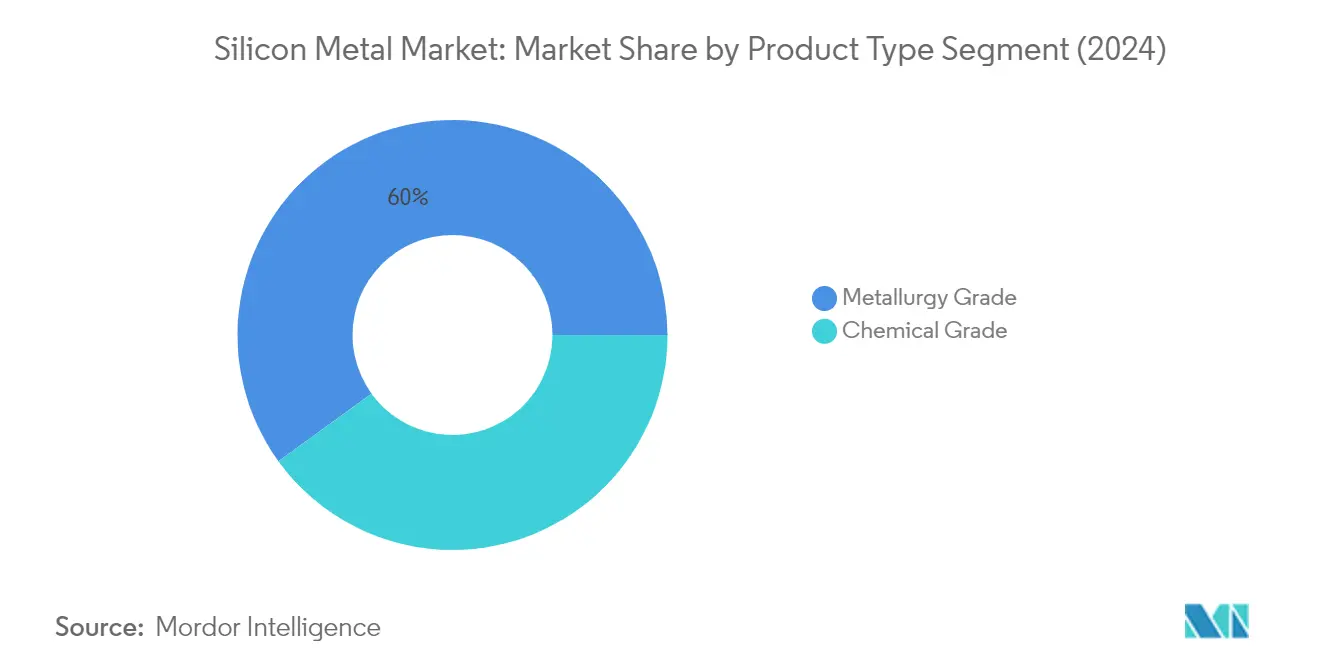
Chemical Grade Segment in Silicon Metal Market
The chemical grade segment plays a vital role in the silicon metal market, serving as a crucial raw material for producing silicones, including sealants and lubricants, silanes, coupling agents, and fumed silica. This grade is essential in manufacturing silicone polymers, which find applications across diverse industries such as construction, electronics, personal care, and automotive sectors. The segment's significance is particularly evident in the production of chemical-grade silicon metal, which begins with the refining process of silica within quartz rock or sand, followed by a carbothermic reduction in an arc furnace to yield metallurgical-grade silicon, and finally undergoes a hydrometallurgical process for further refinement. The versatility of chemical-grade silicon is demonstrated in its wide range of applications, from silicone rubbers and silicon-based oils to greases, sealants, and lubricants, making it indispensable in modern industrial processes. The demand for silicon chemicals and silicon products continues to grow, highlighting the segment's importance in the market.
Segment Analysis: Application
Aluminum Alloys Segment in Silicon Metal Market
The aluminum alloys segment dominates the silicon metal market, commanding approximately 44% market share in 2024. This significant market position is driven by the extensive use of aluminum-silicon alloys in the automotive industry, where these materials serve as crucial components in manufacturing lightweight vehicle parts to improve fuel efficiency and reduce emissions. The segment's dominance is further strengthened by the growing adoption of aluminum alloys in aircraft manufacturing, structural engineering, and the production of hypereutectic Al-Si alloys for premium engine blocks, pumps, compressors, pistons, and transmission components. The automotive industry particularly values silicon's ability to lower alloy density while improving wear resistance, making it instrumental in producing lighter and more durable vehicle components.
Solar Panels Segment in Silicon Metal Market
The solar panels segment is projected to experience the highest growth rate of approximately 7% during the forecast period 2024-2029. This remarkable growth is attributed to silicon's dominance as the primary semiconductor material in solar cells, accounting for about 95% of all modules sold today. The segment's expansion is driven by increasing global renewable energy initiatives, substantial investments in solar power infrastructure, and the superior efficiency and longevity of silicon-based solar cells, which can maintain over 80% of their original power output even after 25 years of operation. The growth is further supported by major economies' ambitious solar capacity addition targets and the continuous technological advancements in silicon-based photovoltaic technology. The role of pure silicon in enhancing the efficiency of solar panels underscores its critical importance in this segment.
Remaining Segments in Application
The silicon metal market's other significant segments include silicones, semiconductors, and various other applications. The silicones segment maintains a substantial presence in the market, driven by its widespread use in thermal insulation materials, sealants, and various industrial applications. The semiconductor segment, though smaller in volume, plays a crucial role in the electronics industry, particularly in the production of electronic components and devices. Other applications encompass diverse uses in stainless steel production, glass manufacturing, and specialty materials, contributing to the market's overall diversity. These segments collectively demonstrate the versatility of silicon metal across multiple industries, from construction and electronics to personal care products and industrial manufacturing. The demand for industrial silicon and silicon materials continues to grow, reflecting the broad applicability of these silicon products.
Silicon Metal Market Geography Segment Analysis
Silicon Metal Market in Asia-Pacific
The Asia-Pacific region dominates the global silicon metal market, driven by robust growth across various end-use industries, including automotive, electronics, and solar energy sectors. China leads the regional market with significant production and consumption capabilities, followed by other key markets like India, Japan, and South Korea. The region's market is characterized by increasing investments in semiconductor manufacturing facilities and the growing adoption of electric vehicles, particularly in countries like China and South Korea. Additionally, government initiatives supporting solar energy development and electronics manufacturing have created substantial opportunities for market expansion across the region.
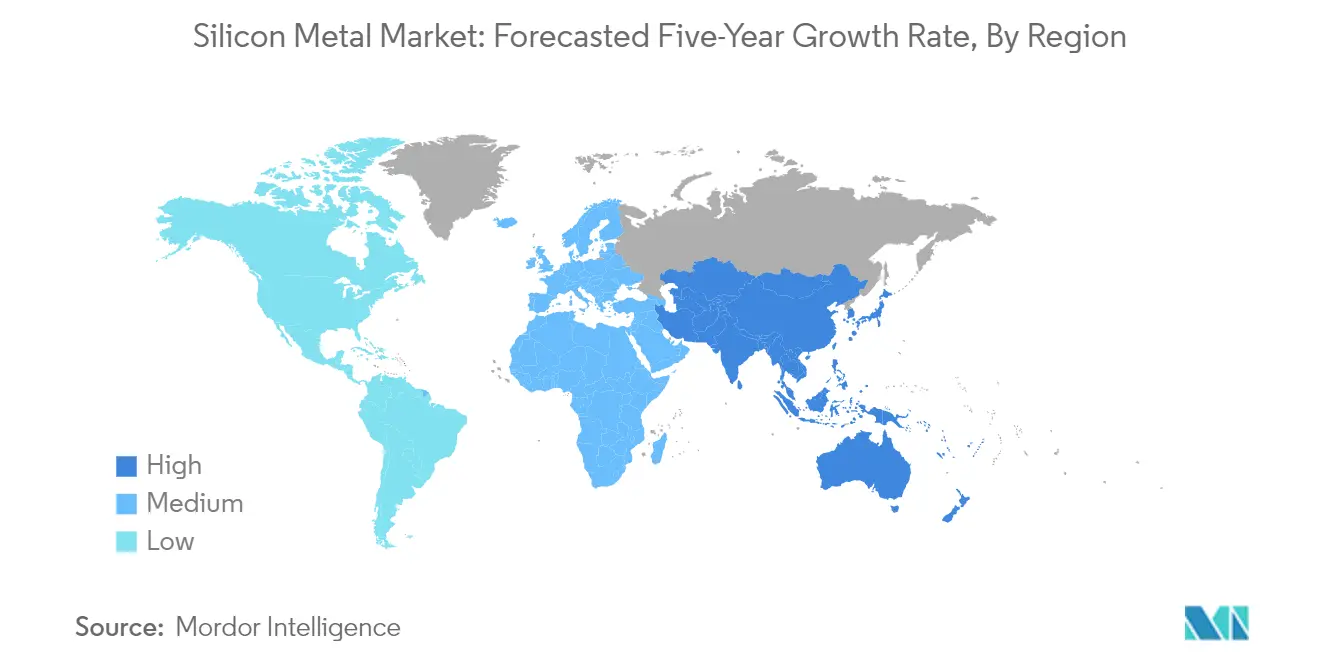
Silicon Metal Market in China
China maintains its position as the largest silicon metal market in Asia-Pacific, accounting for approximately 85% of the regional market share in 2024. The country's dominance is supported by its extensive manufacturing base and leading position in global silicon production. China's silicon metal industry is concentrated in regions like Xinjiang, Yunnan, and Sichuan, where abundant raw materials and affordable electricity are available. The country's robust semiconductor industry, coupled with increasing investments in electric vehicle production and solar energy installations, continues to drive market growth. The government's strategic initiatives like "Made in China 2025" and substantial investments in semiconductor manufacturing facilities further strengthen China's market position.
Silicon Metal Growth Prospects in China
China is also experiencing the fastest growth in the Asia-Pacific region, with a projected CAGR of approximately 6% during 2024-2029. The country's growth trajectory is supported by its expanding solar energy sector, with ambitious targets for renewable energy capacity. China's commitment to developing next-generation products in the electronics industry and increasing focus on electric vehicle manufacturing contributes to this growth. The nation's efforts to strengthen its semiconductor manufacturing capabilities, coupled with ongoing investments in technology parks and production facilities, are expected to further accelerate market expansion. Additionally, the government's support for local manufacturing and technological innovation continues to create new opportunities in the silicon metal market.
Silicon Metal Market in North America
The North American silicon metal market demonstrates strong growth potential, supported by technological advancements and increasing demand from various end-use industries. The United States leads the regional market, followed by Canada and Mexico, with significant consumption in automotive, semiconductor, and solar energy applications. The region's market is characterized by increasing investments in domestic manufacturing capabilities and a growing focus on reducing dependency on imports. Government initiatives supporting clean energy development and semiconductor manufacturing have created favorable conditions for market growth across the region.
Silicon Metal Market in United States
The United States maintains its position as the largest silicon metal market in North America, holding approximately 50% of the regional market share in 2024. The country's market is driven by its robust automotive manufacturing sector and increasing investments in semiconductor production facilities. The implementation of the CHIPS Act and various government initiatives supporting domestic manufacturing has strengthened the country's market position. The U.S. continues to lead in technological innovations and applications of silicon metal across various industries, particularly in solar energy and electronics manufacturing.
Silicon Metal Growth Prospects in United States
The United States demonstrates the highest growth potential in North America, with an expected CAGR of approximately 5% during 2024-2029. This growth is driven by increasing investments in domestic semiconductor manufacturing and expanding solar energy installations. The country's focus on electric vehicle production and renewable energy development creates sustained demand for silicon metal. Additionally, government support for clean energy initiatives and technological advancement in the semiconductor industry contributes to market expansion. The U.S. market benefits from ongoing investments in research and development, particularly in high-purity silicon metal applications.
Silicon Metal Market in Europe
The European silicon metal market demonstrates significant potential, with Germany leading the regional market, followed by the United Kingdom, France, and Italy. The region's market is characterized by strong demand from the automotive sector, particularly in electric vehicle manufacturing. The European Union's focus on renewable energy development and semiconductor manufacturing independence has created new opportunities for market growth. Germany emerges as both the largest and fastest-growing market in the region, driven by its robust automotive industry and increasing investments in solar energy installations.
Silicon Metal Market in Germany
Germany maintains its position as the dominant force in the European silicon metal market, supported by its strong industrial base and technological leadership. The country's automotive sector, particularly its focus on electric vehicle production, drives substantial demand for silicon metal. Germany's commitment to renewable energy development and ongoing investments in semiconductor manufacturing capabilities further strengthen its market position. The country's well-established research and development infrastructure contributes to innovations in silicon metal applications.
Silicon Metal Growth Prospects in Germany
Germany's silicon metal market demonstrates robust growth potential, supported by increasing investments in renewable energy and automotive sector developments. The country's commitment to energy transition and expansion of solar power installations creates sustained demand for silicon metal. Additionally, Germany's focus on developing advanced manufacturing capabilities and increasing adoption of electric vehicles contributes to market growth. The government's support for technological innovation and sustainable development continues to create new opportunities in the silicon metal industry.
Silicon Metal Market in South America
The South American silicon metal market shows steady development, with Brazil and Argentina being key players in the region. Brazil emerges as both the largest and fastest-growing market, supported by its substantial manufacturing base and increasing investments in renewable energy. The region's market benefits from abundant natural resources and growing industrial applications. Various government initiatives supporting manufacturing sector development and increasing focus on sustainable energy solutions contribute to market growth across South America.
Silicon Metal Market in Middle East & Africa
The Middle East & Africa silicon metal market demonstrates growing potential, with Saudi Arabia and South Africa serving as key markets in the region. Saudi Arabia represents the largest market, while South Africa shows the fastest growth potential. The region's market is driven by increasing investments in solar energy projects and growing industrial applications. Government initiatives supporting economic diversification, particularly in Saudi Arabia's Vision 2030, and increasing focus on renewable energy development contribute to market expansion across the region.
Silicon Metal Industry Overview
Top Companies in Silicon Metal Market
The silicon metal market is characterized by continuous product innovation and strategic expansion initiatives by leading players. Companies are heavily investing in research and development to develop advanced silicon manufacturing processes and enhance product quality, particularly focusing on high-purity silicon for specialized applications. Operational agility has become crucial as manufacturers adapt to changing market demands, especially in sectors like electronics and automotive. Strategic moves include vertical integration to secure raw material supply and control costs, while geographical expansion focuses on emerging markets with growing industrial bases. Companies are also emphasizing sustainability in their operations, developing eco-friendly production methods and investing in renewable energy sources for manufacturing processes. The industry has witnessed significant technological advancements in production methods, with companies developing proprietary technologies for improved efficiency and reduced environmental impact.
Consolidated Market with Strong Regional Players
The global silicon metal industry exhibits a partially consolidated structure, dominated by a mix of large multinational corporations and specialized regional manufacturers. Chinese manufacturers hold significant market share globally, while established players in Europe and North America maintain a strong regional presence through specialized product offerings and long-standing customer relationships. The market structure is characterized by high entry barriers due to the capital-intensive nature of operations and technical expertise requirements, which has led to the dominance of well-established players. The industry has witnessed strategic partnerships and joint ventures, particularly focused on technology sharing and market access expansion, rather than outright acquisitions.
The competitive dynamics vary significantly across regions, with different levels of market concentration and competitive intensity. Major players have established integrated operations spanning raw material procurement to end-product manufacturing, while smaller players focus on specific market segments or geographical regions. The industry has seen increased collaboration between manufacturers and end-users, particularly in developing customized solutions for specific applications. Market participants are increasingly focusing on value-added silicon products and services to differentiate themselves in an otherwise commoditized market.
Innovation and Sustainability Drive Future Success
Success in the silicon metal market increasingly depends on technological innovation and sustainable practices. Companies need to focus on developing more efficient silicon production processes while reducing environmental impact to maintain a competitive advantage. Investment in research and development capabilities, particularly in high-purity silicon production, will be crucial for capturing high-value market segments. Market players must also strengthen their supply chain resilience through strategic partnerships and vertical integration while maintaining flexibility to respond to market changes. Building strong relationships with end-users through collaborative product development and technical support will become increasingly important for maintaining market position.
Future market success will require companies to balance cost competitiveness with product quality and environmental responsibility. Players must develop strategies to mitigate the impact of energy cost fluctuations and raw material availability while meeting increasingly stringent environmental regulations. The ability to serve multiple end-user industries and adapt to their evolving requirements will be crucial for maintaining market share. Companies need to invest in digital technologies for process optimization and quality control while developing innovative solutions for emerging applications. Regional players must focus on specialization and customer service excellence to compete effectively with larger global competitors.
Silicon Metal Market Leaders
-
Ferroglobe
-
Dow
-
Wacker Chemie AG
-
Hoshine Silicon Industry Co., Ltd
-
Elkem ASA
- *Disclaimer: Major Players sorted in no particular order
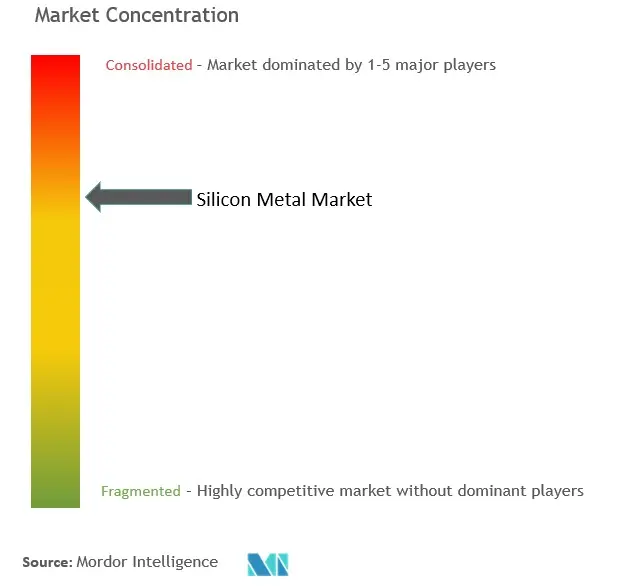
Silicon Metal Market News
- October 2023: Ferroglobe acquired a high-purity quartz mine in South Carolina, the United States. This acquisition was intended to guarantee that Ferroglobe has access to this critical material, which was expected to allow it to meet the growing demand for high-purity silicon metal.
- October 2022: Ferroglobe announced the renewal of the production facility of 55,000 tons of silicon metal in Polokwane, South Africa. The decision to renew the Polokwane facility was intended to increase the company's production capacity of silicon metal.
- August 2022: An agreement between REC Silicon and Mississippi Silicon strengthened the United States' solar supply chain. This agreement helped Mississippi Silicon, in particular the solar industry, maintain a stronghold on silicon metal.
Silicon Metal Market Report - Table of Contents
1. INTRODUCTION
- 1.1 Study Assumptions
- 1.2 Scope of the Study
2. RESEARCH METHODOLOGY
3. EXECUTIVE SUMMARY
4. MARKET DYNAMICS
-
4.1 Drivers
- 4.1.1 Surging Demand from the Automotive Industry
- 4.1.2 Increasing Use in the Solar Industry
- 4.1.3 Increasing Demand for Silicones from Different End Users
-
4.2 Restraints
- 4.2.1 Volatility in Energy Costs
- 4.2.2 Other Restraints
- 4.3 Industry Value Chain Analysis
-
4.4 Porter's Five Forces Analysis
- 4.4.1 Bargaining Power of Suppliers
- 4.4.2 Bargaining Power of Buyers
- 4.4.3 Threat of New Entrants
- 4.4.4 Threat of Substitute Products and Services
- 4.4.5 Degree of Competition
5. MARKET SEGMENTATION (Market Size in Volume)
-
5.1 Product Type
- 5.1.1 Metallurgy Grade
- 5.1.2 Chemical Grade
-
5.2 Application
- 5.2.1 Aluminum Alloys
- 5.2.2 Semiconductors
- 5.2.3 Solar Panels
- 5.2.4 Silicone Derivatives
- 5.2.5 Other Applications (Construction and Infrastructure)
-
5.3 Geography
- 5.3.1 Asia-Pacific
- 5.3.1.1 China
- 5.3.1.2 India
- 5.3.1.3 Japan
- 5.3.1.4 South Korea
- 5.3.1.5 Malaysia
- 5.3.1.6 Indonesia
- 5.3.1.7 Thailand
- 5.3.1.8 Vietnam
- 5.3.1.9 Rest of Asia-Pacific
- 5.3.2 North America
- 5.3.2.1 United States
- 5.3.2.2 Canada
- 5.3.2.3 Mexico
- 5.3.3 Europe
- 5.3.3.1 Germany
- 5.3.3.2 United Kingdom
- 5.3.3.3 Italy
- 5.3.3.4 Spain
- 5.3.3.5 France
- 5.3.3.6 Turkey
- 5.3.3.7 Russia
- 5.3.3.8 NORDIC
- 5.3.3.9 Rest of Europe
- 5.3.4 South America
- 5.3.4.1 Brazil
- 5.3.4.2 Argentina
- 5.3.4.3 Colombia
- 5.3.4.4 Rest of South America
- 5.3.5 Middle-East and Africa
- 5.3.5.1 Saudi Arabia
- 5.3.5.2 South Africa
- 5.3.5.3 Nigeria
- 5.3.5.4 Qatar
- 5.3.5.5 Egypt
- 5.3.5.6 UAE
- 5.3.5.7 Rest of Middle-East and Africa
6. COMPETITIVE LANDSCAPE
- 6.1 Mergers and Acquisitions, Joint Ventures, Collaborations, and Agreements
- 6.2 Market Share(%)**/Ranking Analysis
- 6.3 Strategies Adopted by Leading Players
-
6.4 Company Profiles
- 6.4.1 Anyang Huatuo Metallurgy Co., Ltd.
- 6.4.2 Dow
- 6.4.3 Elkem ASA
- 6.4.4 Ferroglobe
- 6.4.5 Hoshine Silicon Industry Co., Ltd.
- 6.4.6 Liasa
- 6.4.7 Minasligas
- 6.4.8 Mississipi Silicon
- 6.4.9 PCC SE
- 6.4.10 RIMA INDUSTRIAL
- 6.4.11 RusAL
- 6.4.12 Shin-Etsu Chemical Co., Ltd.
- 6.4.13 Wacker Chemie AG
- 6.4.14 Zhejiang kaihua yuantong silicon industry co. LTD.
- *List Not Exhaustive
7. MARKET OPPORTUNITIES AND FUTURE TRENDS
- 7.1 Efforts to Reduce the Cost of Production by Innovating the Existing Technology
- 7.2 Increasing Demand from Renewable Energy Sector
Silicon Metal Industry Segmentation
Silicon is a metallic element derived from quartz and carbonaceous raw materials through a smelting process. It is a hard, brittle, shiny gray metalloid with high thermal and electrical conductivity. Silicon metal is primarily composed of silicon and small amounts of impurities such as iron, aluminum, calcium, and magnesium. It is commonly used as an alloying agent in the production of aluminum alloys, ferrosilicon alloys, and other specialty alloys.
The silicon metal market is segmented by product type, applications, and geography. On the basis of product type, the market is segmented into metallurgy grade and chemical grade. On the basis of applications, the market is segmented into aluminum alloys, semiconductors, solar panels, silicones, and other applications (construction and infrastructure). The report also covers the market size and forecast for silicon metal in 27 countries across major regions.
For each segment, the market sizing and forecast have been done based on volume (tons).
| Product Type | Metallurgy Grade | ||
| Chemical Grade | |||
| Application | Aluminum Alloys | ||
| Semiconductors | |||
| Solar Panels | |||
| Silicone Derivatives | |||
| Other Applications (Construction and Infrastructure) | |||
| Geography | Asia-Pacific | China | |
| India | |||
| Japan | |||
| South Korea | |||
| Malaysia | |||
| Indonesia | |||
| Thailand | |||
| Vietnam | |||
| Rest of Asia-Pacific | |||
| North America | United States | ||
| Canada | |||
| Mexico | |||
| Europe | Germany | ||
| United Kingdom | |||
| Italy | |||
| Spain | |||
| France | |||
| Turkey | |||
| Russia | |||
| NORDIC | |||
| Rest of Europe | |||
| South America | Brazil | ||
| Argentina | |||
| Colombia | |||
| Rest of South America | |||
| Middle-East and Africa | Saudi Arabia | ||
| South Africa | |||
| Nigeria | |||
| Qatar | |||
| Egypt | |||
| UAE | |||
| Rest of Middle-East and Africa | |||
Silicon Metal Market Research FAQs
How big is the Silicon Metal Market?
The Silicon Metal Market size is expected to reach 3.45 million tons in 2025 and grow at a CAGR of 5.41% to reach 4.49 million tons by 2030.
What is the current Silicon Metal Market size?
In 2025, the Silicon Metal Market size is expected to reach 3.45 million tons.
Who are the key players in Silicon Metal Market?
Ferroglobe, Dow, Wacker Chemie AG, Hoshine Silicon Industry Co., Ltd and Elkem ASA are the major companies operating in the Silicon Metal Market.
Which is the fastest growing region in Silicon Metal Market?
Asia Pacific is estimated to grow at the highest CAGR over the forecast period (2025-2030).
Which region has the biggest share in Silicon Metal Market?
In 2025, the Asia Pacific accounts for the largest market share in Silicon Metal Market.
What years does this Silicon Metal Market cover, and what was the market size in 2024?
In 2024, the Silicon Metal Market size was estimated at 3.26 million tons. The report covers the Silicon Metal Market historical market size for years: 2019, 2020, 2021, 2022, 2023 and 2024. The report also forecasts the Silicon Metal Market size for years: 2025, 2026, 2027, 2028, 2029 and 2030.
Our Best Selling Reports
Silicon Metal Market Research
Mordor Intelligence provides a comprehensive analysis of the silicon metal industry. We leverage our extensive expertise in industrial silicon and semiconductor silicon research. Our detailed report covers the entire value chain, from silicon minerals and silicon raw materials to silicon processing and the manufacturing of silicon. The analysis includes key segments such as pure silicon, SI metal, ferrosilicon, and polysilicon. These crucial insights are available in an easy-to-download report PDF format. Our research thoroughly examines silicon materials production processes and emerging trends in silicon chemicals development.
The report offers stakeholders valuable insights into silicon metal price trends and the dynamics of silicon production across global markets. We provide a detailed analysis of various silicon products, including silicon wafers, silicon components, and silicon alloys. The study covers critical aspects of silicon feedstock supply, high purity silicon manufacturing, and developments in the silicon wafer industry. Our comprehensive coverage of the polysilicon market, ferrosilicon market, and the broader silicon metal industry enables businesses to make informed decisions based on current market conditions and future projections.

